Services on Demand
Article
Indicators
Related links
-
 Cited by Google
Cited by Google -
 Similars in Google
Similars in Google
Share
R&D Journal
On-line version ISSN 2309-8988
Print version ISSN 0257-9669
R&D j. (Matieland, Online) vol.2 Stellenbosch, Cape Town 1986
A Fluidity Approach to Non-Newtonian Laminar and Turbulent Flow
J. Harris
Professor, Head of Department of Mechanical Engineering, University of Malawi, Blantyre, Malawi
ABSTRACT
The rheological properties of some non-Newtonian fluids can be equally well represented on the basis of fluidity. The analysis reveals that there can be some advantage in this in that an explicit form for the friction factor in laminar flow is found.
The analysis is extended to the turbulent region and a logarithmic form for the time-average axial velocity in flow is found using a functional analysis method which obviates the need to involve a mixing length hypothesis. The expression for the velocity leads to a friction factor - Reynolds number relation which also has a fluidity number as a parameter.
Methods are considered for the solution of problems which obviate the need for iteration. The corresponding treatment for the usual viscous representation is given in the Appendix.
Nomenclature
a pipe radius
A, A' functions of m and m' respectively
A+ constant defined by equation (47)
B+B2+ integration constants
C, C' functions of m and m' respectively
Cf friction factor defined by equation (22)
D pipe diameter
F( ) function of ...
J flow coefficient in equation (13) (constant)
J' flow coefficient defined by equation (28) (variable)
Κ power-law coefficient equation (1) (constant)
K' power-law coefficient equation (4) (variable)
K" Visco - plastic coefficient in equation (6) (variable)
m fluidity index in equation (13)
m' fluidity index in equation (56)
NR Newtonian Reynolds number
NR' non-Newtonian Reynolds number defined by equation (8)
NHe Hedström number
NF fluidity number defined by equation (25)
fluidity number defined by equation (35)
NRF fluidity Reynolds number defined by equation (24)
fluidity Reynolds number defined by equation (33)
NRF fluidity Reynolds number defined by equation (57)
Q volumetric flow rate
y coordinate normal to the solid surface
ΔP/L pressure gradient
α shear rate constant in equation (14)
a' shear rate factor in equation (27)
γshear rate
μNewtonian viscosity
μρ plastic viscosity in equation (2)
μρ plastic viscosity in equation (5)
ρfluid density
ø fluidity in equation (12)
øf fluidity in equation (14)
ξdimensions coordinate (= y/a)
τ shear stress
τw shear stress at solid boundary
τy effective yield stress in equation (3)
τyeffective yield stress in equations (5) and (6)
Φ ( ), χ ( ), ψ ( ) ... function of ...
Introduction
Laminar and turbulent pipe flow correlations for non-Newtonian fluids have been the subject of quite extensive theoretical analysis and experimental investigation over the last two to three decades. A number of laminar and turbulent correlations have been proposed that mostly rest on the so-called power-law

the Bingham plastic

or the generalised Bingham plastic (plasto-viscous) fluid.

In equations (1) to (3), the fluid parameters Κ, n, μρ, τyare evaluated from viscometric data, in the correct range of shear stress of interest. If pipeline data are available, the equivalent expressions are:
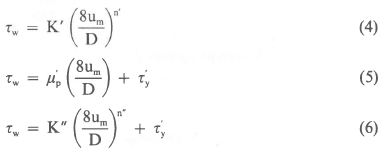
Non-Newtonian friction factor correlations are usually based upon a Reynolds number, which has been defined in a variety of ways, and in the case of materials with an apparent yield stress, a further parameter termed the Hedström number

Such correlations have been summarised by Hey wood (1980) and Heywood and Cheng (1982), for example.
In the laminar region of flow there is no problem in calculating one of the three quantities of pressure gradient, volumetric flow rate or pipe diameter (ΔP/L, Q, D), given the other two, for a power-law fluid. For a plasto-viscous model this is not the case, for the expressions cannot be written explicitly in terms of pressure gradient and therefore to find this for a given volumetric flow rate and pipe diameter, an iterative method must be used that converges on the correct solution.
The turbulent flow of power-law fluids represented either by the viscometric equation (1) or by the pipe-line equation (4) in which K, n, K' and n' are constants, has been treated in various ways, but the most widely quoted is the friction factor - Reynolds number correlation of Dodge and Metzner. (1959). This is based on the defined generalised Reynolds number.

The friction factor - generalised Reynolds number chart contains n (n') as a parameter and provided the volumetric flow rate and pipe diameter are known (and the fluid properties are specified) a friction factor may be determined. The case of either pipe diameter or volumetric flow rate being unknown is treated in this paper. For non power-law fluids, Dodge and Metzner suggest that n' and K' can be variables.
Plasto-viscous fluids of the type exemplified by equations (2) and (3) (or (4) and (5)) have been treated in two ways, that is either by an additional parameter, equation (7) or by using variable K' and n' in equation (4). The problem about this latter method is that to find the appropriate values of K' and n', the proper shear stress level must be known. Harris (1966, 1967, 1968) has questioned the physics of using laminar date for non-Newtonian turbulent flows.
In the present work a plasto-fluidity model is used for laminar flow this leads to an expression which can be explicit in either friction factor, or Reynolds number, and this is not possible for the equivalent Bingham plastic so that to find the wall shear stress (or equivalently, friction factor) an iterative method must be used that converges on the correct solution.
To extend the analysis based on a plasto-fluidity model consideration is given to developing a corresponding expression relating friction factor and Reynolds number in the turbulent region.
In the Appendix methods are described that obviate the need for iterative methods for turbulent flow calculations in the case of the well-known power-law fluids. (Iteratrive methods are not required for laminar flow.)
Fluidity Models
In place of the well-known Newton's viscous law that is written in elementary form as,

one could equally have

where øis the fluidity.
Similarly, in place of equations (1) and (2) one could also have

In equation (14) α is a rate constant, and in this simple case it is given by,

(As may be seen by comparing equations (2) and (14)). The more general case of a plastofluidity model is,

Such fluid models have generally been neglected in the literature up to the present time. Data in the literature may be used ta evaluate constants in the appropriate model. For example Walker and Goulars (1984), publish data on coal and kaolin clay shuries. From this data, for a coal shurry of 1,139 specific gravity the rheological properties may be described as,

Whilst for a kaolin clay slurry of 1,258 specific gravity

Equations (17) and (18) appear to describe the data equally as well as a (generalised) Bingham plastic.
Laminar Flow Analysis
It may easily be shown that the volumetric flow rate in laminar flow is related to the wall shear stress and pipe diameter (under conditions of no apparent slip) by the well-known relation
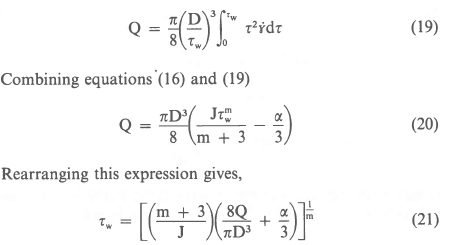
Such a rearrangement is not possible in the case of the corresponding Bingham plastic fluid model. Defining,
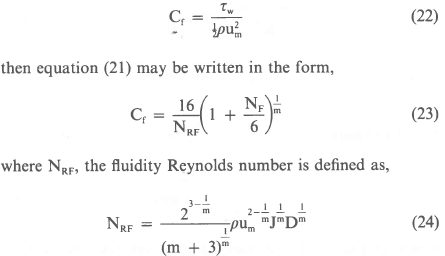
NF, the fluidity number, is defined as

Equation (23) is explicit in the friction factor whereas in the corresponding case of the generalised Bingham plastic the friction factor is not capable of being explicitly expressed. Also from equation (20)

Equation (27) is the form appropriate for pipe flow.
Turbulent Flow Analysis
The turbulent flow analysis below follows the framework outlined by Hunsaker and Rightmire (1947), originally due to Millikan. The same results are obtained from this functional analysis technique as with Prandtl's mixing length theory, but no such physical assumptions as mixing lengths are involved. A smooth bounding surface is considered.
It is assumed that the time-average mean axial velocity as a distance y from the solid boundary can be expressed in the following functional form,

Then by dimensional analysis it may be shown that,
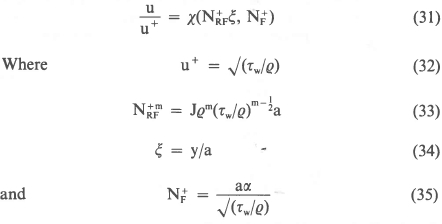
It may be postulated that the velocity defect in the fully turbulent core, is independent of fluid properties, hence,

Also by dimensional analysis it may be shown that the dimensionless velocity defect may be expressed as,
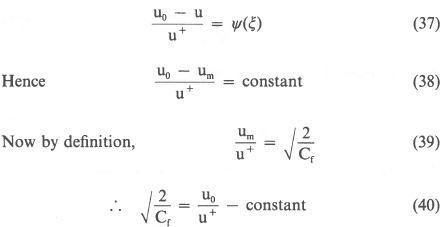
From equation (31) the dimensionless centreline velocity is given by,
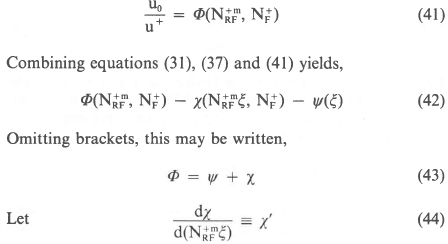
Then differentiating equation (42) in turn with respect to  and ζ, the respective expressions are, (treating
and ζ, the respective expressions are, (treating  as constant),
as constant),
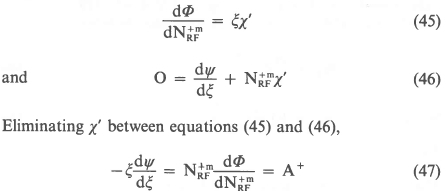
where A is a constant.
Hence, integrating each expression in equation (47) yields,

Thus, the dimensionless velocity, equation (31) is shown to have a logarithmic form. In the case of Newtonian flow this form is found by comparison with experimental data to be valid across a substantial portion of the pipe cross-section, even well into the fully turbulent core. At the present time, such verification is not available for non-Newtonian fluids.
The friction factor - Reynolds number relation may be developed by combining equations (40) and (50), with ξ= 1. This yields,

Noting the combination of NRF and NF in equation (23), it can be postulated that  and
and  in equation (51) will have the same relation and hence if this is the case equation (51) becomes,
in equation (51) will have the same relation and hence if this is the case equation (51) becomes,

From the definitions of NRF, NF, Ν£Ρ and NF in equations (24), (25), (33) and (35) it may be shown that

Hence the friction factor - Reynolds number relation sought is obtained by combining equations (52), (53) and (54),

where A = A (m) and C = C (m) are constants to be determined from experimental data.
Corresponding with the well-known power-law treatment of non-Newtonian fluids by Dodge and Metzner (1959), one could postulate a fluidity model of the form

From this a generalised fluidity Reynolds number may be defined,

Note that in the general case, both J' and m' are functions of τw. The above Reynolds number may be compared with that previously defined in equation (24), from which it may be noted that with m' = m

This is identical in form to equation (28). Then equation (55) would be written in the form,

where A' = A' (m') and C' = C' (m') are determined experimentally.
Although this appears simpler in form than equation (55), in practice complications would arise due to both J' and m' being in general, functions of wall shear stress.
Design Procedures
To avoid using iterative techniques if the volumetric flow rate is required, given the pressure gradient and pipe diameter (and fluid properties) an expression may be developed which is independent of the volumetric flow rate. Thus it may easily be shown that

The right-hand side of this expression may be calculated from the given data and thus the expression may be plotted on the friction-factor Reynolds number chart, which for a constant m' would yield a straight line. The intersection of this with the appropriate friction factor-Renolds number plot gives the required Reynolds number and hence the volumetric flow rate may be calculated.
Similarly, if the pipe diameter is unknown, but the volumetric flow rate and pressure gradient are given it may be shown that

Calculating the right-hand side from the given data and plotting the resulting expression on a friction factor-Reynolds chart would yield a straight line for a constant value of m'. The intersection with the friction factor-Reynolds number curve for the appropiate value of m will again yield the value of Reynolds number from which the pipe diameter may be calculated.
The Appendix outlines the corresponding procedures in the case of power-law fluids and the friction factor chart for these fluids.
Conclusion
The rheological properties of some non-Newtonian fluids in steady laminar shearing motion may sometimes be described in terms of a fluidity model. The use of such a model greatly simplifies the pressure drop-volumetric flow rate relation for flow through a pipe. Furthermore the relation may be made explicit in either pressure gradient or volumetric flow rate, which is not the case for the Bingham plastic model. The friction factor-Reynolds number relation is similarly simplified.
Using a functional analysis method an expression is developed for the friction factor in turbulent flow, based on the analysis of the velocity profile. In this the friction factor becomes a function of the fluidity Reynolds number and a second dimensionless group called here the fluidity number. Logarithmic forms of velocity and friction factor are found.
The expressions derived for the friction factor-Reynolds number relations in the laminar and turbulent region, require experimental verification. A method is given which obviates iteration methods for constant m'. This method also applies to rough pipes.
The Appendix outlines design procedures for power-law fluids which also avoid iterative methods.
In equation (59), A' and C' may be given theoretical forms based on the equivalent Newtonian expression. Thus,

References
1. Heywood, N. I. "Pipeline design for non-Newtonian Fluids" Interflow 1980, I. Chem. E. Conference, Harrogate.
2. Heywood, N. I. and Cheng, D. C. - H. "Comparison of methods for predicting head loss in turbulent pipe flow of non-Newtonian fluids". Inst. Measurement and Control Symposium Nov. 1982, London.
3. Dodge, D. W. and Metzner, A. B. "Turbulent flow of non-Newtonian systems". A. I. Ch. E. Jour. 1959, 5, 189.
4. Harris, J. "Some engineering aspects of non-Newtonian flow". Nature, 1966, 211, 579. [ Links ]
5. Harris, J. "Turbulent flow of non-Newtonian fluids through round tubes". The Chem. Engnr. 1967, No. 213, CE 243. [ Links ]
6. Harris, J. "The correlation of non Newtonian turbulent pipe-flow date." Rheol. Acta, 1968 7, No. 3, 228. [ Links ]
7. Walker, C. L. and Goulas, A., "Performance characteristics of centrifugal pumps when handling non-Newtonian homogeneous shurries". Proc. Instr. Mech. Engrs, 1984, 198 , 41. [ Links ]
8. Hunsaker, J. C. and Rightmire, B. G., "Engineering Applications of Fluid Mechanics". Publ. McGraw-Hill Co. Inc., New York, 1947.
Appendix
Power-Law Pipeline Design Methods
For the turbulent flow region, an expression for friction factor for a power-law fluid has been developed by Dodge and Metzner (1959)

This may be conveniently displayed on a friction factor-Reynolds number chart as shown in figure A1.

If the volumetric flow rate and pipe diameter are known, and η is given, then the friction factor can be determined. There are two other cases to be discussed:
(i) Pressure gradient and pipe diameter known
It may easily be shown that


Therefore again in this case, the right-hand side of equation (A3) may be calculated (and it also applies to rough pipes). Hence this expression may be plotted on Figure A1 and similarly where this intersects the friction factor curve with the appropriate n value, the appropriate Reynolds number is defined, and hence the pipe diameter is found.














